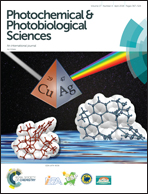Novel indeno[2,1-b]carbazole donor-based organic dyes for dye-sensitized solar cells
Abstract
Four novel metal-free organic dyes (CFB1, CFB2, CFT1 and CFT2) based on indeno[2,1-b]carbazole donors were synthesized and their absorption spectra, photovoltaic performances, and electrochemical properties were evaluated. The differences in linking mode and the number of thiophene units led to variations in absorptivity, electron injection efficiency, and charge recombination. Among the four dyes, CFT1 with a π-bridge at the indeno[2,1-b]carbazole ring and a bridge of thiophene showed the best photovoltaic performance with a JSC of 12.34 mA cm−2, VOC of 0.71 V, and FF of 0.68, corresponding to an overall conversion efficiency η of 5.97% under standard AM 1.5 G irradiation.
![Graphical abstract: Novel indeno[2,1-b]carbazole donor-based organic dyes for dye-sensitized solar cells](/en/Image/Get?imageInfo.ImageType=GA&imageInfo.ImageIdentifier.ManuscriptID=C7PP00350A&imageInfo.ImageIdentifier.Year=2018)


 Please wait while we load your content...
Please wait while we load your content...